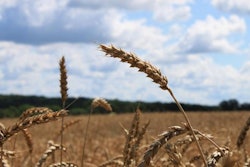
This byproduct of oil extraction from sunflower seeds offers an interesting combination of protein and fiber, usually at an attractive price.
Sunflower meal is the byproduct of oil extraction from sunflower seeds (Helianthus annuus), with sunflower oil being fourth in global production after soybean-, rapeseed- and cottonseed-oil extraction. As sunflowers grow best in colder climates, Russia and Ukraine are the two major producers and exporters of sunflower meal (and oil), with the EU being third in the world. The EU is also a major importer of sunflower meal.
Sunflower oil extraction is done mainly by solvent extraction, although minor quantities of products derived from other extraction methods are usually available locally. The major issue of sunflower meal composition has to do with the amount of sunflower hulls in the final product. Sunflower oil can be extracted from seeds with hulls, partially dehulled, or even completely devoid of hulls. Naturally, the nutritive value (and price) of the byproduct increases as the amount of hulls decreases in the final feed material.
Sunflower seeds, as-is, contain about 42% oil, 16% crude protein and 27% fiber. The fiber is rich in lignin (10%) which makes it interesting enough for certain animal species that require such fiber for certain reasons (rabbits, breeding animals at maintenance). Sunflower meal commercial products are usually classed by their protein content – that also reflects their fiber concentration. Thus, we have, in general, three products:
- Sunflower meal with hulls at 28-30% protein and 25% fiber. This product is ideal for ruminants and monogastric herbivores (rabbits, horses).
- Sunflower meal partially dehulled at 33-35% protein and 21% fiber. This is the most widely available product that can be used at limited amounts even in diets for monogastric omnivores (poultry and swine).
- Sunflower meal completely dehulled at 38-40% protein and less than 15% fiber. This is the ideal product for poultry and swine diets.
In general, the amount of sunflower meal in each animal feed is determined by its fiber concentration (and profile) as there are maximum norms that should be followed in each feed formula. Otherwise, sunflower meal is rather poor in lysine (in contrast to soybean meal) and copper, but rich in calcium and phosphorus. The residual oil in sunflower meal (1-2%) is rich in polyunsaturated linoleic acid (omega-6) and monounsaturated oleic acid (omega-9), something that should be taken into account in feeds for animal species that deposit fats similar to those consumed (this is quite important in the case of enriched eggs and specialty ham products).
In terms of anti-nutritional factors, sunflower meal has no significant compounds that can affect animal performance when used at levels that conform to maximum fiber restrictions in feed formulas. In contrast, sunflower meal contains sugars that increase palatability, something that can be taken into consideration when used in diets for young animals, especially when completely dehulled sunflower meal is available.
In conclusion, despite the widespread use of sunflower oil, nutritionists are not well informed about the many possibilities offered by the different sunflower meal products. Each byproduct can find a place in certain formulas as it can provide a source of protein and/or fiber, as required. Its production in regions that are not producing other protein/oil crops focuses its use in these areas. Quality problems due to variables such as cultivars and inconsistent oil extraction methods have also contributed to some degree into classifying sunflower meal as a secondary protein source, but with proper quality control, sunflower meal can be a first-class feed ingredient.

















